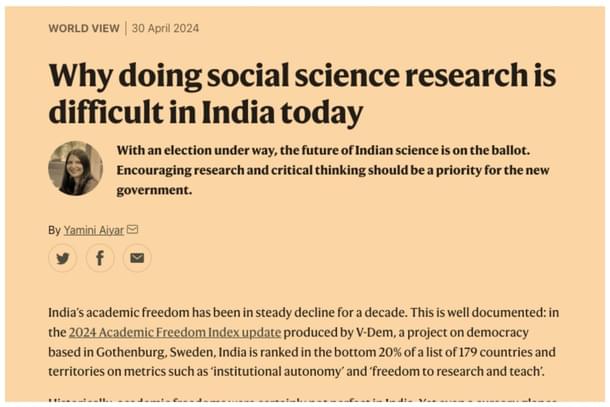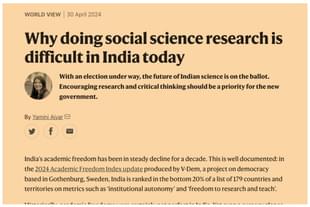Science
Doing 'Social Science': Of 'Nature' and Foreign Nurture
Aravindan Neelakandan
May 09, 2024, 11:19 PM | Updated 11:19 PM IST
Save & read from anywhere!
Bookmark stories for easy access on any device or the Swarajya app.


The prestigious science magazine Nature published two articles on India and science in a span of two weeks.
The first one was published on 16 April, 2024. This piece explained how the proportion of private funding for research in India should increase. It pointed out that around 60 per cent of India’s research spending comes from the central and state governments and universities, and only 40 per cent from the private sector. As against this in the R&D spending of OECD nations, the private sector provides 74 percent funding and in the case of 27 members of the European Union, 66 per cent.
Then the article pointed out that an institutional mechanism has been made by the Bharatiya Janata Party (BJP) government to increase private funding in R&D in the form of the Anusandhan National Research Foundation (ANRF) which has been ‘charged with disbursing 500 billion rupees ($6 billion) to universities and laboratories over 5 years - ‘with 70 per cent of it from non-governmental sources, such as philanthropists and industry.’
While it is too early to see its effects, the article also listed the impressive successes that science has achieved in India – from becoming a global pharmaceutical hub during COVID-19 pandemic to the soft-landing on the moon.
As against this, even as the nation was well into a multi-phase election, came the next article – published on 30 April, 2024.
It was originally titled, ‘Why doing science is difficult in India’. Later, it was changed to ‘Why doing social science research is difficult in India today.’
The change of title suggests an internal churn that should have occurred within Nature upon recognizing the original title's indefensibly rhetorical nature. It appears that this oversight was not initially addressed during the vetting process.
The author of this article is Yamini Aiyar. Aiyar is former president and chief executive of the Centre for Policy Research (CPR). It is one of the six institutions whose FCRA licence and tax-exempt status was revoked after investigation by the income tax authorities.
Aiyar had worked in CPR for seven years and acknowledges that their ‘research relies on international philanthropic funding.’ What is more, CPR or individuals mostly from CPR had also previously faced charges of unethical conduct and corruption.
According to New Indian Express report dated 26 October, 2014, ‘one of the biggest recruitment scams detected by the Vigilance unit of the Airport Authority of India (AAI) in May 2013, was given a quiet burial by the Civil Aviation Ministry in UPA-II on May 16, 2014, the day Lok Sabha election results were declared.’
The newspaper had reported as early as August 2013 about ‘alleged irregularities in recruitment by private recruiting agency, Centre for Policy Research (CPR) to fill over 500 vacancies in 33 grades in the AAI for which advertisements were issued in March 2012.’
Despite repeated requests for an investigation by Vigilance, one of the last acts of the outgoing UPA-II Government was that the concerned Ministry sent a harsh letter to the concerned official, disapproving of the recommendation of a probe against CPR.
That was the clout which CPR enjoyed with the previous political dispensation and now its former ‘president and chief executive’ writes a rhetorical piece against the present government in a top international science magazine with the declaration of ‘no competing interests’.
Should the Indian government be hyper-cautious of CPR relying ‘on international philanthropic funding’? If the past is any indication, then yes.
Anthropologist David H. Rice in his well-documented Cold War Anthropology- The CIA, the Pentagon, and the Growth of Dual Use Anthropology (Duke University Press, 2016) provides page after page of documentation regarding how CIA either sponsored or benefitted from research relying ‘on international philanthropic funding.’
Rice shows that while social science research and policy think-tanks were heavily infested with CIA’s intelligence gathering, even physical sciences were not exempt.
–Michael Lewis’s analysis of the Pacific Ocean Biological Survey (POBS) was a U.S.-financed ornithological study in India in the 1960s. It involved Smithsonian director Dillon Ripley, an eminent ornithologist of impeccable credentials. But the project separately provided data sought by American intelligence agencies. The US Defense Department gained vital knowledge it sought for a biological weapons program from this project. (p. xvii)
–Center for International Studies from the prestigious Massachusetts Institute of Technology (CENIS) In 1962, its Oversight Visiting Committee raised concerns that receipt of CIA funds jeopardized perceptions of the legitimacy of CENIS. In 1965, CENIS was publicly accused of interfering in India’s domestic policy. Consequently in 1966 CENIS ended its funding from the CIA. The fall in the funds from the CIA was compensated by the Ford Foundation which in turn continued supporting what had been CIA-funded projects. (p.93)
–Among the several several international academic journals identified by The New York Times as being secretly financed with CIA funds were the magazines Thought and Quest (India), and the Asia Foundation’s Asian Student. (p.174)
–Asia Foundation (AF), established in 1956, was of course the organisation that employed social sciences including policy studies, anthropology in the service of the CIA.
–In February 1967, the CIA connection to the AF was revealed by The New York Times. In March, the issue rocked the Indian Parliament. The Asia Foundation initially denied its connections with the CIA.
The WAY India Youth Centres Trust was a major target for the Opposition. This was established by Indira Gandhi, Morarji Desai, Naval Tata and R.K.Bajaj. Asia Foundation was a donor to the Trust.
Initially it denied the allegation of CIA connections. But later AF had to admit that it had received 'unrestricted contributions' from Trusts and Foundations which had been recipients of CIA funds.
Finally the WAY Trust, despite its high connections, had to return the money it had received from the Asia Foundation. Cutting across the political spectrum, AF had forged financial ties with many institutions.
But what was surprising for everyone was the revelation that it was the anti-US pro-Communist Krishna Menon who 'was responsible for getting the Asia Foundation established in the country.' (M.V.Kamath, ‘Gandhi's Coolie Life & Times of Ramkrishna Bajaj’, 1995, p.161).
It took one year for the Indira Gandhi Government to order the suspension of all activities of the AF in India despite all the revelations.
It was also around the same time that India’s politicians and a section of the media was also manipulated by the KGB.
Today, the Cold War is over.
The battles fought now are not just between political ideologies but are civilizational conflicts with grave economic implications. The West would prefer an India that is supple and humble before it. An India that provides a passive but a large consumer market and acts as a source of cheap service sector jobs.
Intelligence gathering operates now towards that end. Any government or ideological faction that stands for a self-reliant and strong India, that too through democracy, is a challenge to the deep state in the West. A weakened yet not completely broken India; a skilled but not innovative India; India as a market but not as a self-reliant civilization is what the West would prefer.
How much of the ‘international philanthropic funding’ that Ms. Aiyar talks about actually comes from Western Intelligence agencies can be anyone’s guess. Given such a history, none can blame the current political dispensation for being extremely wary of foreign funding in social science research.





